
Haworth, Supplementum Plantarum Succulentarum 82, 1819
Original Description
What is Opuntia polyacantha?
Opuntia polyacantha is a variable prickly pear cactus ranging from Mexico near California, to Texas, to the Rocky Mountain states and the Great Plains, and north into Alberta and Saskatchewan. In 2018, a disjunct population was discovered in the Thousand Islands region of Ontario, Canada. This prickly pear cactus has even been observed in dry areas in Minnesota and Missouri. In 2018, a disjunct population was discovered in the Thousand Islands region of of Ontario, Canada (Wikipedia). This Opuntia is much more widely spread than the ubiquitous O. phaeacantha.
Details

We recognize 7 varieties of this prickly pear cactus. They represent our concept of the species. Nonetheless, the taxonomy of this Opuntia is complicated, and there are many expressions of O. polyacantha. Some do not fit precisely into the 7 varieties described here. Fruits are dry at maturity; flowers are often yellow but may be orange, pink, or magenta. Seeds are large. O. polyacantha is tetraploid, but perhaps one or more other ploidies are represented in this large and diverse group of prickly pears. It is possible that new taxa will be recognized within the currently broad concept of the taxon.
O. polyacantha is generally reported to be tetraploid, but studies have not been performed for all varieties.
Varieties
Other species have been treated as varieties of O. polyacantha including O. nicholii and O. trichophora (see Powell and Weedin). But these are treated as separate species herein because they are hexaploid or diploid, respectively and because they are don’t intergrade with the varieties described here.
O. polyacantha erinacea (Engelmann & J.M. Bigelow) B.D. Parfitt, Cactus and Succulent Journal (Los Angeles) 70(4): 188. 1998
Herbarium; Herbarium; Herbarium; Herbarium; Herbarium; Herbarium
Opuntia polyacantha erinacea has areoles that are usually large and relatively close together. The cladodes are typically very thick and often elongate. The plants tend to form upright clumps. They have many spines, usually mostly slender and terete. The spines can be stiff or hair-like, even on the same plant (some eastern populations of this prickly pear cactus have mostly plants with very thick stiff relatively short spines). The spines of this prickly pear cactus vary in color but are often light. The fruit is usually more elongate than in var polyacantha and often reddish when initially ripe (but soon fading to brown or tan as they dry). O. polyacantha erinacea is found in rocky areas (occasionally sandy areas) in the Mojave Desert and on hot rocky south slopes in the Great Basin Desert north almost to (or perhaps into) Idaho. It grows in hotter areas of canyons up the Colorado and San Juan Rivers into southern Utah and almost to the Four Corners in Arizona (it was mostly behind dam building and populations were destroyed by reservoirs). This Opuntia variety grows in southeastern California, Nevada, northern Arizona, Utah, and Colorado. Plants at high elevations in the Mojave Desert and southern California sometimes spread more than typical plants and sometimes are nearly spineless, whereas some plants at lower elevations may have enough spines to visually obscure the stem. Some botanists consider O. polyacantha var erinacea to be a separate cactus species, but we treat it as a variety of O. polyacantha herein, especially because it intergrades with, and readily interbreeds with, the other varieties.
O. polyacantha hystricina (Engelmann & J.M. Bigelow) B.D. Parfitt, Cactus and Succulent Journal (Los Angeles) 70(4): 188. 1998
Herbarium; Herbarium; Herbarium; Herbarium; Herbarium; Herbarium; Herbarium; Herbarium; Herbarium
Opuntia polyacantha hystricina is very much like var erinacea, but the joints of this Opuntia are usually not so thick, and the plants are broader, lower, and more openly spreading in habit (as is the case for most O. polyacantha varieties). This prickly pear cactus is found in areas with at least a modicum of summer rainfall in cold winter deserts and in grasslands from eastern Nevada and southwestern Utah to southwestern Colorado, central New Mexico, and across most of northern Arizona.
O. polyacantha juniperina (Britton & Rose) L.D. Benson, Cacti of Arizona (ed. 3) 20. 1969
Herbarium; Herbarium; Herbarium; Herbarium; Herbarium; Herbarium; Herbarium
Opuntia polyacantha juniperina is much like var polyacantha in many traits, but it has much fewer spines that are confined to the upper areoles or which may be nearly completely absent. The lower areoles of this Opuntia may have only one or two tiny spines or no spines. The fruit is often spineless or nearly so. This prickly pear cactus is found in mountainous areas of the Colorado Plateaus and Southern Rocky Mountains, but it is rare in the Front Range region. It is found in southern Wyoming, Colorado, eastern Utah, northern Arizona, and northern and central New Mexico. Similar groups of plants are scattered into Idaho and north into northern Wyoming and in the Black Hills as well as the higher plateaus and mountain country of northern Arizona. It is replaced to the west by var utahensis (the division is the north-south trending, central high plateaus and mountains of Utah). It usually grows in open conifer woodland, mountain scrub, or in areas of sagebrush.
O. polyacantha polyacantha (autonym) Haworth
Lectotype; Herbarium; Herbarium; Herbarium; Herbarium; Herbarium; Painting
Opuntia polyacantha polyacantha forms a low spreading prickly pear cactus and usually has roundish pads (shape varies somewhat). The areoles are small and close together in this Opuntia. The spines are numerous with one stout, terete central spine that is is often 2 to 2.5 cm long (occasionally another one or two centrals may be present that are likely to be flattened). Several (to many) smaller spines radiate around the central. Spine color is highly varied and has been the basis for several of synonymous names. Fruit of this prickly pear cactus tends to be roundish with short stout spines. It grows mostly in grasslands but occasionally into scrub and woodlands in mountains. It is found on the Great Plains and in the Rockies, from Alberta, Saskatchewan, and Minnesota southward to central New Mexico, and the panhandles of Texas and Oklahoma. This Opuntia has been reported in IA and MO. It also occurs in southern Idaho and eastern Utah. Similar plants grow in the Columbia Basin between the Blue Mountains and southern British Columbia that seem to represent this variety too; these may be westward continuations of populations in Idaho and Montana.
O. polyacantha rhodantha (K.Schum.) M.H.J.van der Meer, Cact. Phantast. 2020(11)-1: 1
Neotype; Herbarium; Herbarium; Herbarium; Herbarium
Opuntia polyacantha rhodantha has areoles that are large and relatively far apart. Stem segments are usually very thick and may be elongate; they are generally “lumpy” because the areoles are prominent. Generally, cladodes are dark- or dull-waxy green. The spines of this Opuntia variety are stout, varied in color, and have annulate markings. The fruit has prominent (sometimes elevated) areoles that are relatively far apart, usually with stout short spines (but sometimes nearly spineless). This Opuntia is found mostly in desert in the northern parts of the Colorado Plateau and the Great Basin but also overlapping into the Southern Rockies, the Snake River Plains, and the Wyoming Basin. It also grows in Utah, western Colorado, southwestern Wyoming, southern Idaho, southeastern Oregon, and parts of eastern Nevada.
O. polyacantha schweriniana. Die Cactaceae: Handbuch der Kakteenkunde; (K.Schum.) Backeb. Cactaceae (Backeberg) 1: 607 1958
Herbarium; Herbarium; Herbarium; Herbarium; Herbarium; Herbarium; Herbarium; Herbarium; Herbarium
Opuntia polyacantha schweriniana tends to be a miniature replica of vars polyacantha, juniperina, or hystricina–spination in this prickly pear cactus varies. It grows at high elevations (often above the other varieties) in the Southern Rocky Mountains in eastern Utah, Colorado, northern New Mexico, southern Wyoming, with pockets of similar plants further north in Wyoming and in the Black Hills. Also, a few patches at high elevations occur in the San Juan drainage in northeastern Arizona. See the original description (as O. schweriniana).
O. polyacantha utahensis Parfitt, Cactus and Succulent Journal 70(4): 188. 1998
Neotype; Herbarium; Herbarium; Herbarium
Opuntia polyacantha utahensis has areoles that are relatively far apart. The cladodes are most often thickish and elongate, sometimes a bit lumpy (usually not), and light in color. The cladodes may be yellowish-green and the spines are usually pale white to yellowish in color. The spines are slender. The areoles of this prickly pear cactus are relatively far apart on fruit and sometimes spineless. It is found mostly in lower mountains in woodland or scrub, but sometimes it occurs in sagebrush areas. It grows in eastern California (rare), Nevada, western Utah, and perhaps into southern Idaho and southeastern Oregon.
O. polyacantha “other varieties” (Engelmann & J.M. Bigelow) B.D. Parfitt
Opuntia polyacantha is a widespread species found from Canada and the northern Midwest to California and down the backside of the Sierra Nevada mountains into Mexico. Some plants don’t fit into the varieties we describe and are worthy of more study. This prickly pear cactus is one of the most widespread Opuntia in the United States.



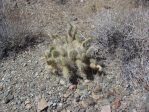




















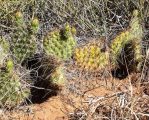
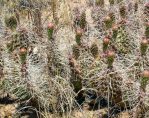








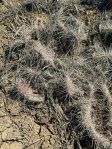

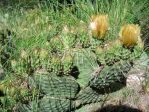



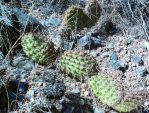
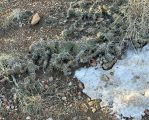






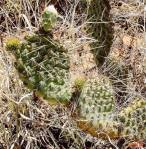
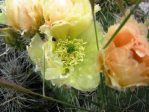


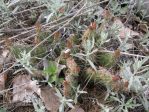









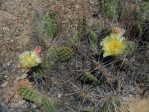





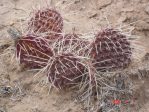



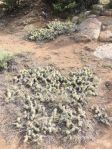
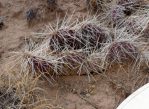












Please tell me the fruiting requirements of cold hardy opuntia. I am in a short season, only guaranteed 90 frost free days, but generally there are more. Zone 4
I don’t understand it the fruits are day length sensitive or heat unit dependant, or length of season dependant or all three and am unable to find information, except for one study in India.
I sent an email to one of the emails.posted and didn’t receive an answer and am not sure who to contact. Thanks for any info and help.
Hi,
I don’t know if 90 days is enough time, but it might be.
Joe